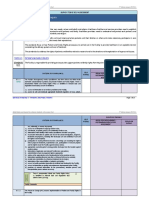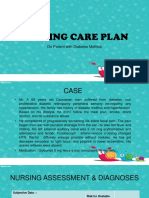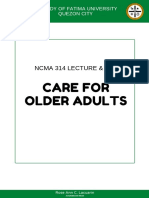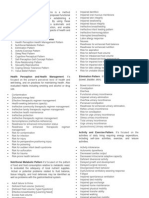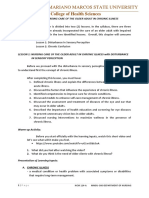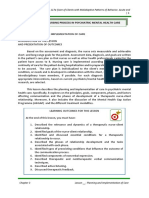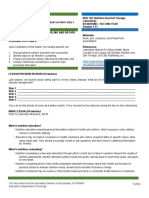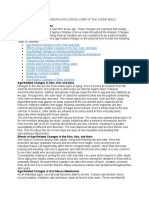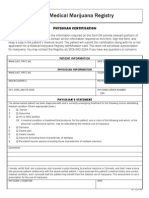Pain Management Guidelines
Pain Management Guidelines
Uploaded by
Mr. BamsCopyright:
Available Formats
Pain Management Guidelines
Pain Management Guidelines
Uploaded by
Mr. BamsOriginal Description:
Copyright
Available Formats
Share this document
Did you find this document useful?
Is this content inappropriate?
Copyright:
Available Formats
Pain Management Guidelines
Pain Management Guidelines
Uploaded by
Mr. BamsCopyright:
Available Formats
THE UNIVERSITY OF TOLEDO
MEDICAL CENTER
Title: PAIN MANAGEMENT
Responsibility: Registered Nurse (RN)
Nursing Service
Nursing Guideline
Purpose: To provide adequate pain control and improve the quality of life for those experiencing pain.
Specific Notes: When pain is experienced, the body reacts with a complex physiological response: heart rate
quickens, respiration increases, muscles tense, and hormones are released. Should pain persist
and remain unchecked, these physiological effects can put a strain on an individual's health
and well-being.
Procedure
1. Assess for pain and discomfort upon arrival to the
nursing unit/service and every shift.
Pain assessment is performed more frequently as
needed per patient.
Pain will be reassessed after interventions to ensure
patient comfort and documented no later than the
end of the shift.
If pain intervention is provided within one hour of
end of the shift the next shift will be responsible for
documenting the reassessment.
2. Utilize the appropriate rating scale for the
individual being assessed.
Rating scale is to be selected based on patient.
Rating scales for adults may include: Visual analog
scale; the 0-1 0 pain rating scale; the Wong Baker
Pain Faces Scale; Adult nonverbal pain scale.
The FLACC rating scale may be used for children
and adults.
Assess location, duration, description, precipitating
and alleviating factors, and effects on activities of
daily living (ADL).
3. Educate patient on the following:
Importance of using a standardized tool.
Importance of open communication.
Patients right to pain control measures.
Effects of pain not properly managed on
recovery.
Address concerns of addiction.
Expected benefit from pain medication.
Expected side effects from pain medications.
Point of Emphasis
Maintain pain control at a level acceptable to the patient.
Determine the patient's pain goal and document in the
patient's electronic admission medical record.
Assessment of pain for patients with an epidural or
intravenous (IV) patient controlled analgesic (PCA) will be
completed according to the Guidelines established.
Take into consideration the patient's age, mental status,
cognitive and communication abilities and any co-
morbidity when choosing a scale.
As the interpretation of pain and how it is experienced is
subjective, it can be a difficult symptom to assess;
therefore, a complete assessment must be obtained.
The University of Toledo Medical Center has determined
that pain rated at '0' is no pain, 1-3 to be mild, 4-7 to be
moderate, and 8-10 to be severe.
The patient is an important part of the team and must
recognize his/her responsibilities and rights.
Pain medications should decrease, but may NOT alleviate
pain completely; therefore, realistic goals should be
fostered.
Side effects include: constipation, sedation, nausea/
vomiting, pruritis, hallucinations, confusion/delirium and
respiratory depression.
1. Dosage regimens are dependent on both
Pain Management Guidelines
Page 2 of3
Procedure
4. Consider patients medical history and condition in
relation to pain therapy.
5. Implement measures to reduce discomfort according
to physician orders: stagger them to receive a more
consistent level of control.
Medication orders that include a range order,
(or pain medication, will be administered
according to the standards established in
policy 3364-133-17 Medication Control and
Distribution.
Administer pain medications proactively, such
as before a dressing change, procedures, or
therapy.
Decrease negative environmental stimuli.
Teach and assist in relaxation techniques.
Utilize non-pharmacological interventions.
Administer pain medication promptly.
If multiple pain meds are ordered be sure to
6. Call light within reach.
7. Notify physician if above interventions are
ineffective.
8. Document assessment/reassessments, interventions,
effectiveness, and patient education in the patient's
medical record.
Point of Emphasis
pharmacokinetic and pharmacodynamic factors and may
change with age, chronic disease states and other
concurrent medications.
2. Take into consideration patients with history of sleep
apnea, respiratory disease, renal disease, liver disease and
age (pediatric patients and elderly patients) when ordering
and administering dose.
Diversonal activities and relaxation technique
aid in pain reduction.
The use of cold applications may be very effective in
decreasing procedural pain.
Repositioning can be used to decrease spasm and stiffness.
Dosage should be started at the lowest level and increased
as needed.
Medication by mouth should be the first route of
medication selected.
Documentation ofeffects, either positive or negative,
should be entered in the patient's medical record.
Oral and intravenous pain medications may be
administered simultaneously when a physic an order is
present indicating this and the pain level is 8 or greater,
respiratory rate> or =10, level o[consciousness is
arousable and capable of.(ollowing simple commands.
Common scenarios whre concurrent IV/PO therapy may
be appropriate include:
I. Oral narcotics administered while IV therapy is
still in use to facilitate the weaning of. the IV
therapy.
2. Oral therapy is adequate to manage pain but
occasional IV therapy is necessary to manage
break-through episodes of.pain.
Utilize the chain of command up to the attending physician
if necessary.
Document physician contacted, any change in medication
orders or new plan of care received (e.g. Consult pain
management) in patients medical record.
Reassessment should include whether the patient's goal
for pain relief was met (for example, pain intensity, effect
on function [physical or psychosocial]), patient satisfaction
with pain relief, whether side effects had occurred and
were tolerable.
Pain Management Guidelines
Page 3 of3
Revised by: M. Cathy Benninghoff, MSN, RN, CNS; & Greg Shannon, MSN, RN.
Approved: 2/2005
Reviewed: 7/2011
Revised: 7/2007, 1/08, 8/08. 3/2/11, 6/24/11, 7/14/11, 3/14
Reviewed by Policy & Standard Committee 2/2011, 6/11, 7/11
References: Carr, E., Meredith, P., Chumbley, G., Killen, R., Prytherch, D. R., & Smith, G. B. (2014). Pain: A
quality of care issue during patients' admission to hospital. Journal of Advanced Nursing, 70(6), 1391-
1403.
Perry, A.G., Potter, P.A., Ostendorf, W.R. (2014). Clinical nursing skills & techniques (8th ed.). St.
Louis: Mosby.
Mosby Nursing Skills. Retrieved on March 10, 2014, from
http:/ /mns. elsevierperformancemanager. com/NursingSkills/ContentPlayer/Skill ContentPlayer !Frame. aspx
?Keyld=5 87 &Id=GN _ 06 _1 &Section= 1
You might also like
- Essentials of Gerontological NursingDocument346 pagesEssentials of Gerontological NursingbabeNo ratings yet
- Comprehensive Geriatric Assessment ToolDocument10 pagesComprehensive Geriatric Assessment ToolAmeraidah Patorai100% (2)
- Gliclazide and Sulodexide Nursing ResponsibilitiesDocument1 pageGliclazide and Sulodexide Nursing ResponsibilitiessekwetNo ratings yet
- Geriatric Assessment FormDocument3 pagesGeriatric Assessment FormEsmeralda Barnaha100% (1)
- Nursing Care PlanllDocument5 pagesNursing Care Planllbbarnes0912No ratings yet
- Handouts-IV Therapy Documentation PDFDocument12 pagesHandouts-IV Therapy Documentation PDFTony DemaguilNo ratings yet
- NCLFNP - Mr. Robert McClelland CaseDocument4 pagesNCLFNP - Mr. Robert McClelland CaseAiresh Lamao50% (2)
- An Case Study - WebsiteDocument5 pagesAn Case Study - Websiteapi-249707182No ratings yet
- Lesson 12 15finalsDocument25 pagesLesson 12 15finalsREIMOND VINCE MENDOZANo ratings yet
- JCI Booklet Final EditedDocument40 pagesJCI Booklet Final EditedRei IrincoNo ratings yet
- MSQH 5th Edition Standard 06 - Patient and Family Rights-Jan 2017 PDFDocument31 pagesMSQH 5th Edition Standard 06 - Patient and Family Rights-Jan 2017 PDFGarFieLd macHeLoNo ratings yet
- PNS Pain Management Guideline For Nursing CompetencyDocument10 pagesPNS Pain Management Guideline For Nursing Competencyvhon100% (1)
- Assessment of Older People 5: Assessing The Social DomainDocument4 pagesAssessment of Older People 5: Assessing The Social DomainSuci ErvindaNo ratings yet
- Teaching Plan For Pain ManagementDocument5 pagesTeaching Plan For Pain ManagementKramSenarevol100% (1)
- Reflective Journal of Geriatric ClinicalDocument10 pagesReflective Journal of Geriatric ClinicalDeebu Sathasivan100% (1)
- Nursing Informatics/TelenursingDocument9 pagesNursing Informatics/TelenursingPatricia Havens ThomasNo ratings yet
- Comprehensive Geriatric AssessmentDocument6 pagesComprehensive Geriatric AssessmentAnne Laureta100% (1)
- Study Guide 6 - Transcultural Perspectives in ChildbearingDocument12 pagesStudy Guide 6 - Transcultural Perspectives in ChildbearingTim john louie RancudoNo ratings yet
- Assessment of The Elderly 3Document32 pagesAssessment of The Elderly 3Tanwir Houssayn100% (1)
- Nursing Care PlanDocument26 pagesNursing Care PlanDinda Mareta100% (1)
- Page 17 ACUTE PAIN Related To Joint Stiffness Secondary To Aging.Document3 pagesPage 17 ACUTE PAIN Related To Joint Stiffness Secondary To Aging.Senyorita KHayeNo ratings yet
- NCP Format Acute PainDocument2 pagesNCP Format Acute PainRainier IbarretaNo ratings yet
- Nursing Care Plan - MergedDocument13 pagesNursing Care Plan - MergedJuls Flares SycaycoNo ratings yet
- NCMB 314 Finals ReviewerDocument24 pagesNCMB 314 Finals ReviewerANGELICA MACASONo ratings yet
- Gordons TypologyDocument37 pagesGordons TypologyJo PigarNo ratings yet
- NUR C307 - M1 - Concepts, Principles and Theories in The Care of Older AdultsDocument38 pagesNUR C307 - M1 - Concepts, Principles and Theories in The Care of Older Adultsnoo.wannNo ratings yet
- Exploration of Geriatric Care Competencies In.4Document8 pagesExploration of Geriatric Care Competencies In.4Mesh CoyivNo ratings yet
- Meniere's Disease - Case StudyDocument3 pagesMeniere's Disease - Case StudyZORANASNNo ratings yet
- Lesson 1 Management of CareDocument21 pagesLesson 1 Management of CareJazzmineDominguezBoncalesNo ratings yet
- Nil by Mouth Best Practice and Patient EducationDocument3 pagesNil by Mouth Best Practice and Patient EducationGrace SimarmataNo ratings yet
- 7 Important Euthanasia Pros and ConsDocument2 pages7 Important Euthanasia Pros and ConsChristian ArbolerasNo ratings yet
- Gordon'sDocument2 pagesGordon'sCham Rafaela ConeseNo ratings yet
- Clinical Pathway For Family Wellness Promotion in Elderly: Junayyah A. Sarip Jaeron Den D. TopinioDocument36 pagesClinical Pathway For Family Wellness Promotion in Elderly: Junayyah A. Sarip Jaeron Den D. TopinioJunayyah Abdullah SaripNo ratings yet
- Movie AnalysisDocument7 pagesMovie Analysisapi-542795774No ratings yet
- Chapter 3-GERIADocument25 pagesChapter 3-GERIA3D - AURELIO, Lyca Mae M.No ratings yet
- Community Health Nursing I (Individual and Family) : Prepared By: Mrs. Lavinia T. Malabuyoc, MAN, R.NDocument48 pagesCommunity Health Nursing I (Individual and Family) : Prepared By: Mrs. Lavinia T. Malabuyoc, MAN, R.NLerma Pagcaliwangan100% (1)
- Group 1 Physiological Changes in Aging Affecting Various SystemsDocument22 pagesGroup 1 Physiological Changes in Aging Affecting Various SystemsIra LampayanNo ratings yet
- What Is Copar?: COPAR Stands For Community Organizing Participatory Action ResearchDocument4 pagesWhat Is Copar?: COPAR Stands For Community Organizing Participatory Action ResearchRAMIL GOPEZNo ratings yet
- Palliative and End-of-Life CareDocument12 pagesPalliative and End-of-Life CareCosbyNo ratings yet
- Theories of Aging in NursingDocument2 pagesTheories of Aging in NursingLieana AguilarNo ratings yet
- Nursing Care PlanDocument8 pagesNursing Care PlanssucbotNo ratings yet
- Imbalanced Nutrition Nursing Diagnosis & Care Plan (2023 Guide)Document18 pagesImbalanced Nutrition Nursing Diagnosis & Care Plan (2023 Guide)Stella FongNo ratings yet
- Chapter 2 Lesson 3 Learning Input 1 2Document26 pagesChapter 2 Lesson 3 Learning Input 1 2Myla Claire AlipioNo ratings yet
- The Relationship Between Nursing Informatics Competency and Clinical Decision-Making Among Nurses in West Bank, PalestineDocument7 pagesThe Relationship Between Nursing Informatics Competency and Clinical Decision-Making Among Nurses in West Bank, Palestineاحمد العايديNo ratings yet
- CHN NotesDocument7 pagesCHN NotesAnvi Turingan PedronanNo ratings yet
- Geria NotesDocument8 pagesGeria NotesPCIs DR RotationNo ratings yet
- Care For Elderly PDFDocument10 pagesCare For Elderly PDFDzulfiqarNo ratings yet
- Pathophysiology of Cerebral SchistosomiasisDocument2 pagesPathophysiology of Cerebral SchistosomiasisRisa Sol AriasNo ratings yet
- Care of The Elderly Quiz 1Document6 pagesCare of The Elderly Quiz 1Susan MaglaquiNo ratings yet
- Pain Management ChecklistDocument2 pagesPain Management ChecklistLyka Dimayacyac100% (2)
- Geriatric For JustineDocument28 pagesGeriatric For JustineJaylord VerazonNo ratings yet
- Diabetes Mellitus Type 2 1Document47 pagesDiabetes Mellitus Type 2 1DESIRYL IAN LOPINANo ratings yet
- Care of Older Adult Full Notes For Next Weeks QuizDocument14 pagesCare of Older Adult Full Notes For Next Weeks QuizMercy Anne EcatNo ratings yet
- Session 21Document5 pagesSession 21nicoleangela ubasroselloNo ratings yet
- Tutorials On GenitourinaryDocument15 pagesTutorials On Genitourinaryabangjojo123No ratings yet
- PHYSICAL AND PSYCHOLOGICAL CARE OF THE OLDER ADULT (AutoRecovered)Document19 pagesPHYSICAL AND PSYCHOLOGICAL CARE OF THE OLDER ADULT (AutoRecovered)Gladz C CadaguitNo ratings yet
- Discharge Planning PaperDocument5 pagesDischarge Planning Paperapi-283173905No ratings yet
- Family Coping IndexDocument3 pagesFamily Coping IndexERMIAS, ZENDY I.No ratings yet
- Culture+and+Health+Care Reaction+Paper+1Document5 pagesCulture+and+Health+Care Reaction+Paper+1Janeel CowanNo ratings yet
- Older People - Patterns of Illness, Physiological Changes and Multiple PathologyDocument4 pagesOlder People - Patterns of Illness, Physiological Changes and Multiple PathologyTweenie Dalumpines100% (1)
- Clinical Reflective JournalDocument4 pagesClinical Reflective Journalapi-547521437No ratings yet
- Ventricular Septal Defect, A Simple Guide To The Condition, Treatment And Related ConditionsFrom EverandVentricular Septal Defect, A Simple Guide To The Condition, Treatment And Related ConditionsNo ratings yet
- Chronic Pain NandaDocument7 pagesChronic Pain NandaJude Bello-AlvearNo ratings yet
- AuditDocument3 pagesAuditMr. BamsNo ratings yet
- Investigating The Diagnostic Language of Nursing Practice: NANDA InternationalDocument23 pagesInvestigating The Diagnostic Language of Nursing Practice: NANDA InternationalMr. BamsNo ratings yet
- Journal of BTDocument19 pagesJournal of BTMr. BamsNo ratings yet
- NANDA Nursing Diagnosis For 2012-2014, With 16 New Diagnoses. (Total 237 Diagnosis)Document4 pagesNANDA Nursing Diagnosis For 2012-2014, With 16 New Diagnoses. (Total 237 Diagnosis)Mr. BamsNo ratings yet
- Infection Control ReportDocument11 pagesInfection Control ReportMr. BamsNo ratings yet
- Effective Date:: 0 V'-Lu - 1:2-E - I 1 l-6l3Document1 pageEffective Date:: 0 V'-Lu - 1:2-E - I 1 l-6l3Mr. BamsNo ratings yet
- Infection Control Construction PermitDocument2 pagesInfection Control Construction PermitMr. BamsNo ratings yet
- 3364-110-07-06 Nursing ServiceDocument2 pages3364-110-07-06 Nursing ServiceMr. BamsNo ratings yet
- Effective DateDocument2 pagesEffective DateMr. BamsNo ratings yet
- (A) Policy Statement: Name of Policy: Policy Number: Department: Approving Officer: Responsible Agent: ScopeDocument2 pages(A) Policy Statement: Name of Policy: Policy Number: Department: Approving Officer: Responsible Agent: ScopeMr. BamsNo ratings yet
- Toledo: Policy StatementDocument2 pagesToledo: Policy StatementMr. BamsNo ratings yet
- 2.risk For Bleeding: Short Term Goal: Short Term GoalDocument2 pages2.risk For Bleeding: Short Term Goal: Short Term GoalMr. BamsNo ratings yet
- 2.risk For Bleeding: Short Term Goal: Short Term GoalDocument2 pages2.risk For Bleeding: Short Term Goal: Short Term GoalMr. BamsNo ratings yet
- Basic Trauma & Cardiac Life SupportDocument2 pagesBasic Trauma & Cardiac Life SupportMr. BamsNo ratings yet
- Logfile OkfdDocument11 pagesLogfile OkfdMr. BamsNo ratings yet
- Basic Trauma & Cardiac Life SupportDocument2 pagesBasic Trauma & Cardiac Life SupportMr. BamsNo ratings yet
- Basic Trauma & Cardiac Life SupportDocument2 pagesBasic Trauma & Cardiac Life SupportMr. BamsNo ratings yet
- Basic Trauma & Cardiac Life SupportDocument2 pagesBasic Trauma & Cardiac Life SupportMr. BamsNo ratings yet
- Assessing Pain in The Elderly: N C P K PDocument2 pagesAssessing Pain in The Elderly: N C P K PMr. BamsNo ratings yet
- Medical Ethics and Patient CareDocument7 pagesMedical Ethics and Patient Caresatya2212No ratings yet
- Duties and ResponsibilitiesDocument25 pagesDuties and ResponsibilitiesAbhyuday KumarNo ratings yet
- Confidential - Do Not Disclose or Distribute Applicant Information To Persons Outside The Residency/fellowship Application ProcessDocument5 pagesConfidential - Do Not Disclose or Distribute Applicant Information To Persons Outside The Residency/fellowship Application Processmmmmder7No ratings yet
- 04 Mecical Record and Abbreviation - FADocument28 pages04 Mecical Record and Abbreviation - FANur FitrianiNo ratings yet
- General Hospital StandardDocument182 pagesGeneral Hospital StandardabanchayeuNo ratings yet
- Physician CertificationDocument1 pagePhysician CertificationcwadotorgNo ratings yet
- Maintaining Best Practice in Record-Keeping and DocumentationDocument7 pagesMaintaining Best Practice in Record-Keeping and DocumentationRetno Indah PertiwiNo ratings yet
- Chapter OneDocument1 pageChapter OneTundex ConceptNo ratings yet
- Patient EducationDocument5 pagesPatient EducationRS Sentra Medika CisalakNo ratings yet
- NCM 103 - Fundamentals in NursingDocument46 pagesNCM 103 - Fundamentals in NursingCLARENCE REMUDARONo ratings yet
- Clinical Documentation Improvement ProgramDocument4 pagesClinical Documentation Improvement ProgramMohammed Gazo50% (2)
- Smart Health Consulting Online System Using BlockchainDocument8 pagesSmart Health Consulting Online System Using BlockchainIJRASETPublicationsNo ratings yet
- Team 3 125 126 Homework PPT 6 & 7Document5 pagesTeam 3 125 126 Homework PPT 6 & 7L M FadhilNo ratings yet
- Med Record ClerkDocument3 pagesMed Record ClerkrengikrishnaNo ratings yet
- Failures of Record KeepingDocument11 pagesFailures of Record KeepingsomeguyinozNo ratings yet
- Yenepoya Nursing College: 9/21/2020 1 Naac Webinar, YncDocument41 pagesYenepoya Nursing College: 9/21/2020 1 Naac Webinar, YncAnand gowdaNo ratings yet
- PrelimReviewer NCM110LectDocument18 pagesPrelimReviewer NCM110LectJustine Simeon lagunzadNo ratings yet
- MR Ahm Medical RecordDocument12 pagesMR Ahm Medical RecordTanti Farida Rahman100% (1)
- Ovr OrientationDocument66 pagesOvr OrientationMelai Rodriguez IbardalozaNo ratings yet
- Summary of Board's ActionsDocument4 pagesSummary of Board's ActionsGabriel OgbonnayaNo ratings yet
- CRI Healthcare Procedure Manual 240218Document40 pagesCRI Healthcare Procedure Manual 240218Poornima DeviNo ratings yet
- Attitudes of Nursing Staff Towards Computerization: A Case of Two Hospitals in Nairobi, KenyaDocument76 pagesAttitudes of Nursing Staff Towards Computerization: A Case of Two Hospitals in Nairobi, KenyaNjoku UchechukwuNo ratings yet
- Nursing ProcessDocument52 pagesNursing ProcessDzon LornaNo ratings yet
- HASTING CENTER The Privacy Rule That's NotDocument11 pagesHASTING CENTER The Privacy Rule That's NotIon Arrieta ValeroNo ratings yet
- Researcher Training Manual: Bannatyne Campus Research Ethics BoardDocument26 pagesResearcher Training Manual: Bannatyne Campus Research Ethics BoardJohn BerlinNo ratings yet
- Aplikasi E-Health Kesehatan Ibu Dan Anak (KIA)Document6 pagesAplikasi E-Health Kesehatan Ibu Dan Anak (KIA)Dwi RahmawatiNo ratings yet
- Thesis Archives and Records ManagementDocument7 pagesThesis Archives and Records Managementwyppfyhef100% (2)










